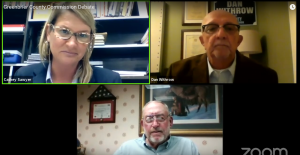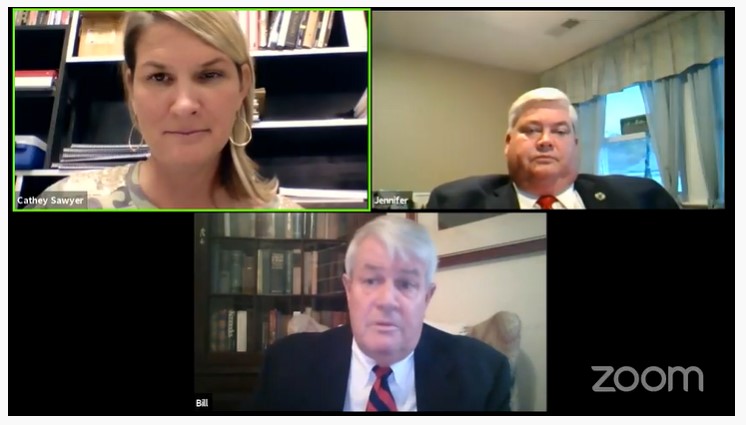By Lyra Bordelon
The Greenbrier County Commission President Lowell Rose and challenger Dan Withrow found much to agree on, with one major exception, during the Greenbrier County Chamber of Commerce’s debate between the two candidates. Held virtually over Zoom, and available on youtube.com on the nonpartisan Chamber of Commerce’s page, the two candidates discussed the Greenbrier County Sportsplex, infrastructure, and tourism.

The main point of disagreement between the two candidates is the Greenbrier County Sportsplex, a 143-acre project located near the Greenbrier River and the Greenbrier County Landfill. Not to be confused with the Greenbrier Valley Aquatic Center, a privately funded multi-pool recreational complex on land donated by the State Fair of West Virginia, the Sportsplex has been financed by the county’s bed tax, a 3 percent charge on hotels, motels, Airbnbs, and other similar businesses. Approximately $2 million has been spent on the project since it truly began in 2017.
A big reason for the Sportsplex creation by the County Commission is the to capture the sports-based tourism market created by all levels of recreational sports, from Little League tournaments to college-level sporting events. Teams currently need to travel to other communities for the larger event games.
“Our Greenbrier County Softball League spends $20,000 in Covington to put on tournaments because we don’t have a place in the county,” Rose said “You cannot send people from town to town to town to put on a tournament, you have to have a central place. … These folks spend anywhere from $800 to a couple thousand dollars for a weekend trip out of state or out of the area.”
Withrow disagreed with the need for one central location for tournaments.
“If we had taken some of that $2 million and upgraded the fields in the small towns, Ronceverte, White Sulphur, Lewisburg, Rainelle, we could start hosting these softball, baseball, and soccer tournaments in these small towns, which would be beneficial to them,” explained Withrow. “… I was one of the founders of the ASA travel ball, we traveled up and down he east coast and we would play one game, jump in the car and go 45 minutes to an hour to the next field to play. I think it’s very feasible and very possible to utilize the fields that we’ve got and down the road look and see if this area is ready to sustain a full-size sportsplex.”
Withrow also criticized the Sportsplex’s location, citing an offer to build the park on land donated from the State Fair of West Virginia.
“I am in favor of the Sportsplex, however I’m not in favor of the location, and I’m not in favor of the money that’s being spent,” Withrow said. “… They have spent $2 million already, they need another 4 to 6 million to complete this project. There are no public utilities there, there are no amenities, and it has very poor access.”
In November 2017, the commission hosted an event at Greenbrier Valley Theatre, providing information about the then-unnamed sports complex. The land offered by the State Fair of Wet Virginia was described as about 30 acres and would have required extensive rock-drilling to get the property ready for a Sportsplex. Rose echoed these points during the debate.
“The location [the State Fair of West Virgina] wanted to give us was a hard area to grade out,” Rose said. “It was a steep hillside, a bunch of sinkholes. The parking was going to have to be in the grassy area of the fairgrounds. That area wasn’t going to work for us, wasn’t going to give us enough [space for the fields].”
Rose endorsed the facility’s current location.
“I think it’s a great location – we have 143 acres,” Rose said. “It takes 88 acres just to do the five soccer fields and the four baseball fields, and the parking lots, we’ve got in our [current design]. We’ve got all the basic grading done, gravel in the parking lots, that material was donated to us by the airport. … It’s four miles from the interstate. It’s a two lane road, from the top of the hill to the sports complex has just been redone and repaved.”

Previously, Rose and Commissioner Michael McClung have approved multiple bids and payments for work on the project – many of the Sportsplex’s construction phases have been divided, allowing for bids on each section of work, rather than one major company contracting the entire project. However, votes for the project work are typically 2-1, with Commissioner Tammy Shifflett-Tincher voting against.
“I understand completely the idea and the concept but financially we cannot do this as a county,” Tincher said in one August 2019 commission meeting. “One of the things I was very much impressed by when I became a commissioner was the fiscal conservatism that these fellow commissioners beside me have had over the past few years. The county was in the red … and the county is doing well financially in our general budget. [I don’t support this] because there is no plan in place. There is no building plan, there’s no operating budget, there’s just ‘when there’s enough money in the account we’re going to move forward.’ As a responsible commissioner that has a fiduciary responsibility to the county, I do not believe that is the proper method we need to proceed with.”
Tincher then pointed to a lack of budgets and plans for the project and the average arts and recreation income over the past four years, $613,000, as being too low to fund both the Sportsplex and other arts and recreation grants.
Withrow also cited local attorney David Hammond, who has previously spoken out against the project. Hammond previously was the chairman of the Kanawha County Building Commission when the revenue bonds to build the Shawnee Park sports complex were issued. According to Hammond, the park cost more that $18 million to construct, with the county already owning the land and utilities on installed. In addition, he cites the Shawnee park’s $765,000 operating budget, after construction, as higher than Greenbrier County’s annual hotel/motel budget.
Rose pushed back, explaining the Greenbrier County facility’s differences could account for the commission’s efforts.

“There are a lot of ways I am able to conserve money and get a project done for less than, for example, the Shawnee project,” Rose said. “[In that project], money was thrown out like crazy, we’re not doing that.”
Rose also emphasized the funds do not come from local tax payers, but from the profits on tourism. Half of the hotel/motel tax funds the Greenbrier County Convention and Visitor’s Bureau, the main organization working to bring tourists to the county. In addition, Rose noted plans to set up a steering committee, seeking private donors and grant funds.
“The funds come from out of town people coming in and staying, mainly at The Greenbrier, 99.9 percent of it, so there’s been no tax money spent on that,” Rose said. “I have plans to set up a control group to go after private donations and grants.”
On many other issues, the candidates found much to agree on. Each candidate voiced support for the future of Greenbrier County tourism through the support of the Convention and Visitors Bureau and the outdoor opportunities the area presents, the continuing development of partnerships between the various county organizations, something that has been difficult to do in the past, the new administration at the Greenbrier Valley Airport, Governor Jim Justice’s use of CARES Act funding to fix drainage issues in Fairlea, and continuing support for the Greenbrier County Humane Society.
In their closing statements, Rose and Withrow took different directions.
Withrow pointed to his exercise routine, explaining that he has “been running for 45 years and has not missed a day of running in over 36 years. The last day I did not run was December 26, 1983, and what I will say to the citizens of Greenbrier County, if I am elected to the Greenbrier County Commission I will bring to the County Commission the dedication I have to my running for the last 36 and 45 years of running.”
Rose highlighted his efforts on a number of infrastructure projects throughout the county, such as the years-long waterline extension in Sam Black, the over $15 million estimated Tax Increment Financing (TIF) projects, ongoing efforts to get an internet access tower in Quinwood, and upcoming plans for an addition to the courthouse, providing a more secure way to transport suspects to and from court.
To watch the debate in full, go youtube.com and search for the Greater Greenbrier Chamber of Commerce, where the House of Delegates, State Senate, and Greenbrier County Commission are each available.



